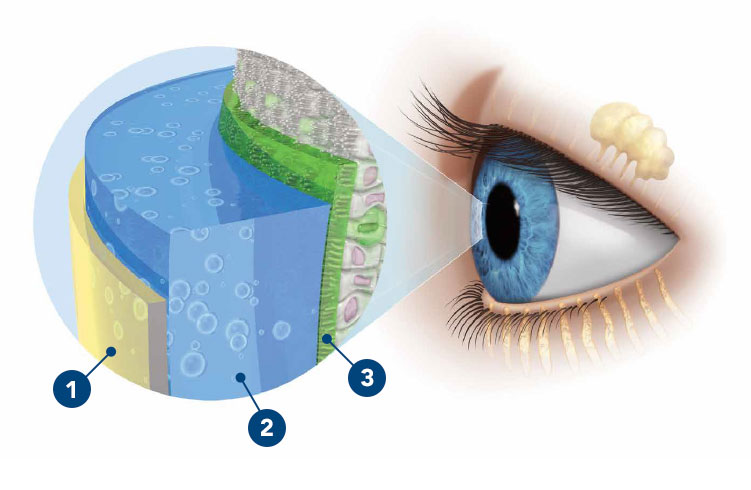What are Tears?
There are three main components that are crucial in forming the tear film that coats the cornea and keeps your eyes feeling moist and comfortable:

1. Lipid Layer
Located on the outermost part of the tear film, the lipid (oil) layer stabilizes the tear film. When you have Meibomian Gland Dysfunction (the most common type of dry eye) your tear film has less oil, so your tears evaporate too quickly.1-5,7,8
2. Aqueous Layer
The Aqueous Layer is the largest portion of your tear film, responsible for supplying the moisture your eyes need to be comfortable. If you have Aqueous Layer Deficiency, your eyes don’t produce enough of the watery component of tears, which makes it harder for your eyes to stay moist.1-4
3. Mucin Layer
This innermost layer consists of proteins called mucins that coat the eye and allow the Aqueous Layer to “stick” to the otherwise water-repellent cornea.1-3,7
All three layers are necessary to create an ideal tear film for moist, healthy eyes. If any layer becomes depleted, the tear film cannot properly coat your eyes and dry spots can form. This causes your eyes to become symptomatic and uncomfortable.2
The SYSTANE® Family of Products has options that help replenish your tears and relieve dry eye symptoms.

References:
- National Eye Institute. http://www.nei.nih.gov/health/dryeye/factsaboutdryeye.pdf Pages 1, 2. Accessed March 12, 2013.
- Mayo Clinic. http://www.mayoclinic.com/health/dry-eyes/DS00463/DSECTION=causes Pages 1, 2, 3. Accessed March 5, 2013.
- 2007 Report of the International Dry Eye WorkShop (DEWS). http://www.tearfilm.org/dewsreport/pdfs/TOS-0502-DEWS-noAds.pdf Pages 75, 87.
- The International Workshop on Meibomian Gland Dysfunction: Report of the Definition and Classification Subcommittee. http://www.iovs.org/content/52/4/1930.full.pdf Pages 1930, 1935.
- The International Workshop on Meibomian Gland Dysfunction: Report of the Subcommittee on Anatomy, Physiology, and Pathophysiology of the Meibomian Gland. http://www.tearfilm.org/dewsreport/pdfs/TOS-0502-DEWS-noAds.pdf Pages 1338, 1353.
- Holly F, Lemp MA. Formation and rupture of the tear film. Exp Eye Res 1973; 15: 515-25.
- Bron AJ. Diagnosis of dry eye. Surv Ophthalmol 2001; 45 Suppl 2: S221-6.
- Craig J, Tomlinson A. Importance of the lipid layer in human tear film stability and evaporation. Optom Vis Sci. 1997; 74: 8-13.

